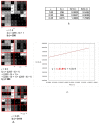Application of Texture and Fractal Dimension Analysis to Evaluate Subgingival Cement Surfaces in Terms of Biocompatibility
- PMID: 34640254
- PMCID: PMC8510438
- DOI: 10.3390/ma14195857
Application of Texture and Fractal Dimension Analysis to Evaluate Subgingival Cement Surfaces in Terms of Biocompatibility
Abstract
Biocompatibility is defined as "the ability of a biomaterial, prosthesis, or medical device to perform with an appropriate host response in a specific application". Biocompatibility is especially important for restorative dentists as they use materials that remain in close contact with living tissues for a long time. The research material involves six types of cement used frequently in the subgingival region: Ketac Fil Plus (3M ESPE, Germany), Riva Self Cure (SDI, Australia) (Glass Ionomer Cements), Breeze (Pentron Clinical, USA) (Resin-based Cement), Adhesor Carbofine (Pentron, Czech Republic), Harvard Polycarboxylat Cement (Harvard Dental, Great Britain) (Zinc polycarboxylate types of cement) and Agatos S (Chema-Elektromet, Poland) (Zinc Phosphate Cement). Texture and fractal dimension analysis was applied. An evaluation of cytotoxicity and cell adhesion was carried out. The fractal dimension of Breeze (Pentron Clinical, USA) differed in each of the tested types of cement. Adhesor Carbofine (Pentron, Czech Republic) cytotoxicity was rated 4 on a 0-4 scale. The Ketac Fil Plus (3M ESPE, Germany) and Riva Self Cure (SDI, Australia) cements showed the most favorable conditions for the adhesion of fibroblasts, despite statistically significant differences in the fractal dimension of their surfaces.
Keywords: cytotoxicity; dental cements; fibroblasts adhesion; fractal dimension analysis; subgingival restoration; texture analysis.
Conflict of interest statement
The authors declare no conflict of interest.
Figures









References
-
- Anderson J.M. Biological Responses to Materials. Annu. Rev. Mater. Res. 2001;31:81–110. doi: 10.1146/annurev.matsci.31.1.81. - DOI
Grants and funding
LinkOut - more resources
Full Text Sources

